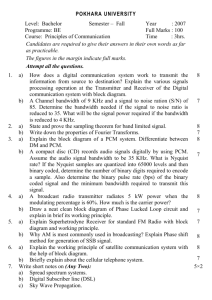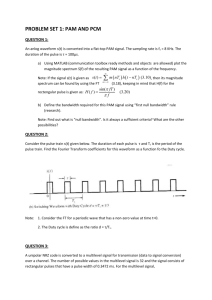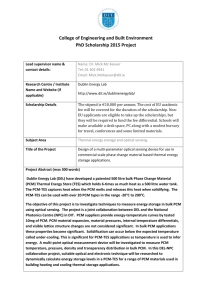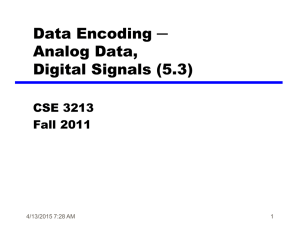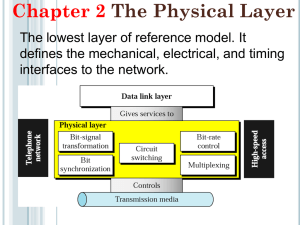Bandwidth of PCM signals (word format)
advertisement
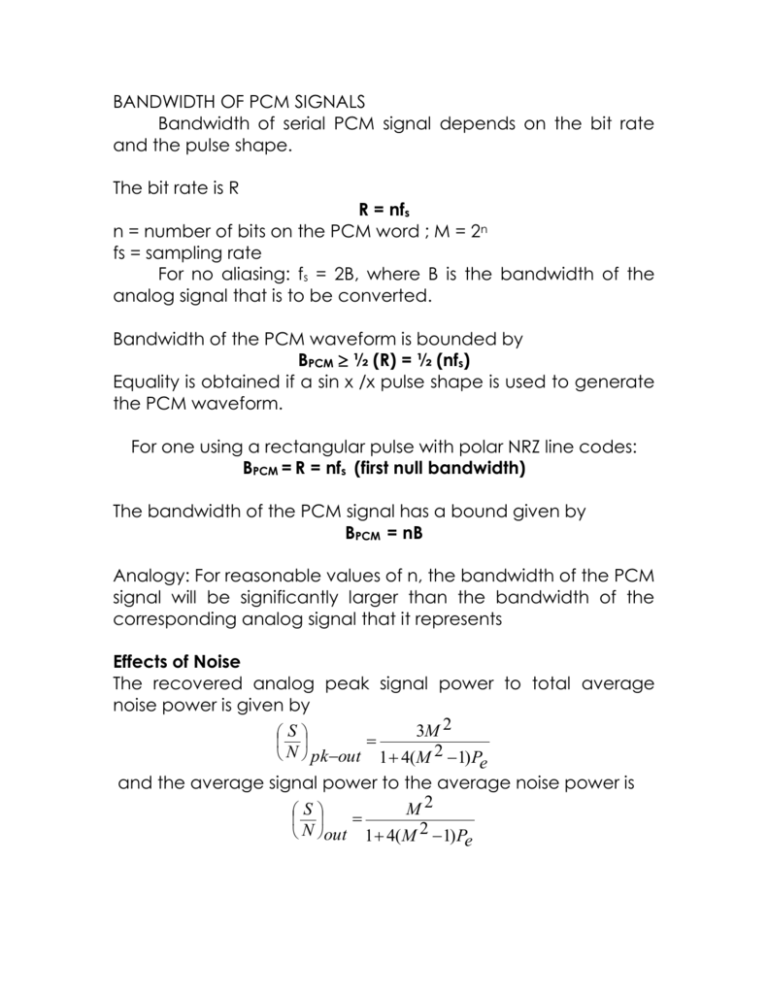
BANDWIDTH OF PCM SIGNALS Bandwidth of serial PCM signal depends on the bit rate and the pulse shape. The bit rate is R R = nfs n = number of bits on the PCM word ; M = 2n fs = sampling rate For no aliasing: fs = 2B, where B is the bandwidth of the analog signal that is to be converted. Bandwidth of the PCM waveform is bounded by BPCM ½ (R) = ½ (nfs) Equality is obtained if a sin x /x pulse shape is used to generate the PCM waveform. For one using a rectangular pulse with polar NRZ line codes: BPCM = R = nfs (first null bandwidth) The bandwidth of the PCM signal has a bound given by BPCM = nB Analogy: For reasonable values of n, the bandwidth of the PCM signal will be significantly larger than the bandwidth of the corresponding analog signal that it represents Effects of Noise The recovered analog peak signal power to total average noise power is given by 3M 2 S N pk out 1 4(M 2 1) P e and the average signal power to the average noise power is M2 S N out 1 4( M 2 1) P e where M is number of quantized levels used in the PCM system and Pe is the probability of bit error in the recovered binary PCM signal at the receiver DAC before it is converted back to an analog signal. In most practical Pe is negligible. As result: S 3M 2 N pk out and S M2 N out Expressing in dB: S 6.02n N dB where n is the number of bits in the PCM word, = 4.77 for the peak SNR and = 0 for the average SNR. Analogy: This is called the 6 dB rule, which points out a significant performance characteristic for PCM: an additional 6 dB improvement in SNR is obtained for each bit added to the PCM word. Dynamic Range - ratio of the largest possible magnitude to the smallest possible magnitude that can be decoded by the DAC. V DR = max 2 n 1 V min Digital Signaling The baud (symbol rate) is D = N / To (symbols/sec) N= number of dimensions used in To second. The bit rate is R = n / To n= number of data bits sent in To second For the case of binary signaling: n= N Multilevel signaling – the waveform is assigned with more than two possible values. Bandwidth estimation Using the dimensionality theorem, the bandwidth of a waveform w(t) is B N 1 D 2To 2 If sin x / x type is used, lower bound of absolute bandwidth is achieved. For other pulse shapes, bandwidth will be larger than the lower bound. Binary-to-Multilevel Signal Conversion L-level multilevel signal Binary signal ŀ-bit DAC Message source (binary output) D symbols/sec =R bits/sec L=2l D symbols/sec =R/l bits/sec In general, for the case of L = 2l levels, the null bandwidth is Bnull = R/l Problems: 1. In a communications-quality audio system an analog voice frequency (VF) signal with a bandwidth of 3200 Hz is converted to a PCM signal by sampling at 7000 samples/sec and using a uniform quantizer of 64 steps. The PCM binary data is transmitted over a noisy channel to a receiver that has a bit error (BER) of 10-4. (a) What is the null bandwidth of the PCM signal if a polar line code is used? If sin x/x pulse shapes are used? (b) What is the average SNR of the recovered analog signal at the receiving end? 2. A unipolar NRZ line code is converted to a multilevel signal for transmission over a channel. The number of possible values in the multilevel is 32 and the signal consists of rectangular pulses that have a pulse width of 0.3472 ms. For the multilevel signal (a) what is the baud? (b) what is the equivalent bit rate? (c) what is the null bandwidth?(d) repeat a to c for the unipolar NRZ line code. 3. The information in an analog voltage waveform is to be transmitted over a PCM system with a 0.1% accuracy (full-scale). The analog waveform has an absolute bandwidth of 100 Hz and an amplitude range of –10 to +10V. (a) Determine the minimum sampling rate needed. (b) Determine the number of bits needed in each PCM word. (c) Determine the minimum bit rate required in the PCM signal. (d) Determine the minimum absolute channel bandwidth required for transmission of this PCM signal. 4. The information in an analog waveform is first encoded into binary PCM and then converted into a multilevel signal for transmission over the channel. The number of multilevel is 8. Assume that the analog signal has a bandwidth of 2700 Hz and is to be reproduced at the receiver output with an accuracy of 1% (full scale). (a) Determine the minimum bit rate of the PCM signal. (b) Determine the minimum baud of the multilevel signal. (c) Determine the minimum absolute bandwidth required for transmission of this PCM signal.
